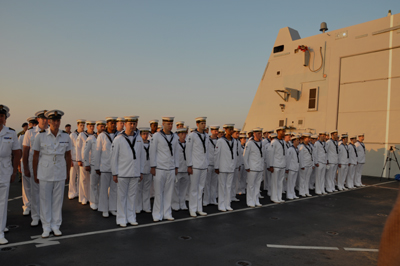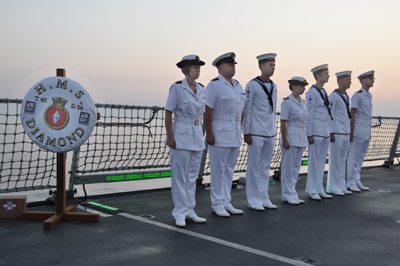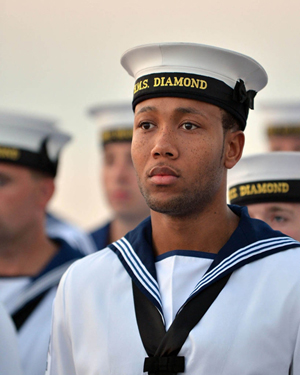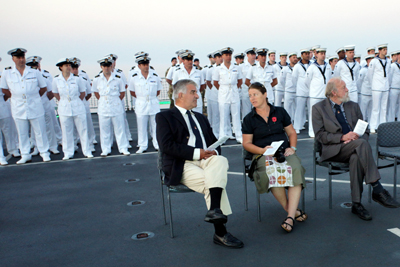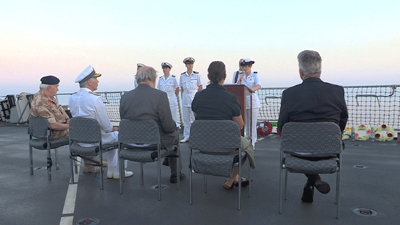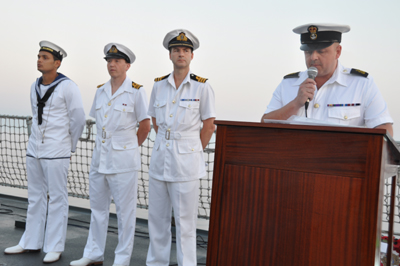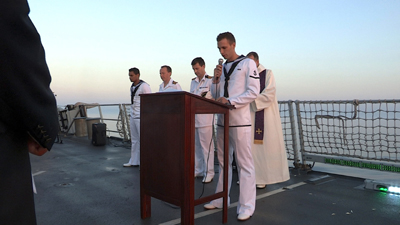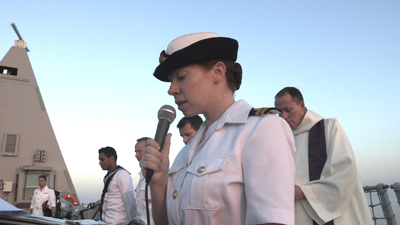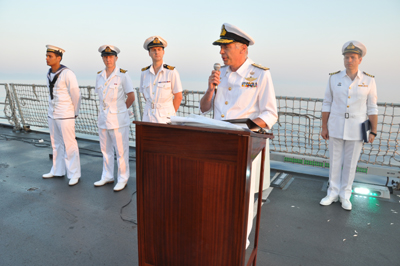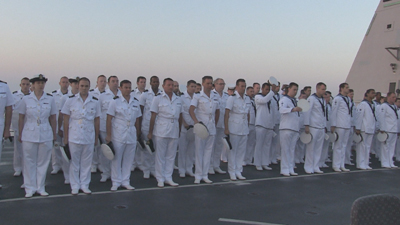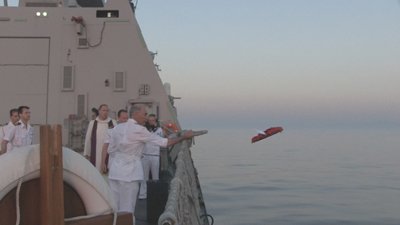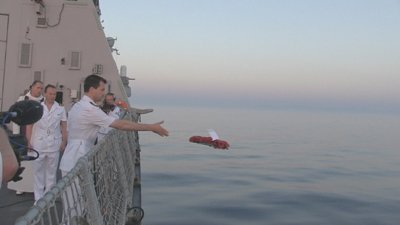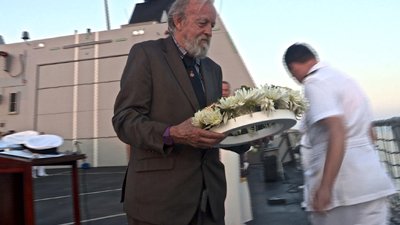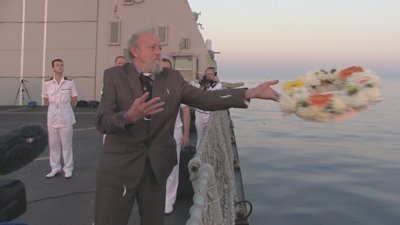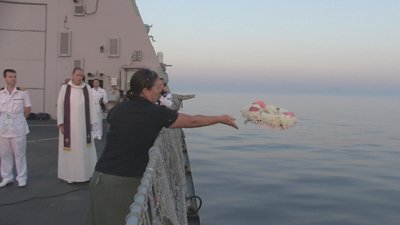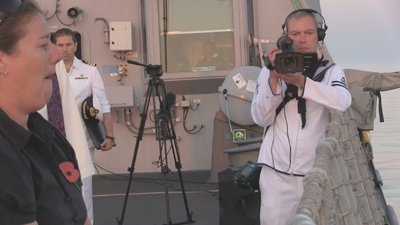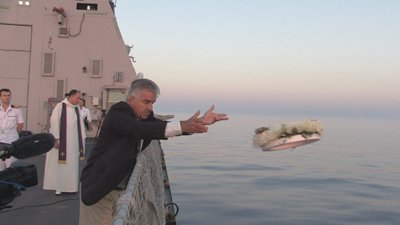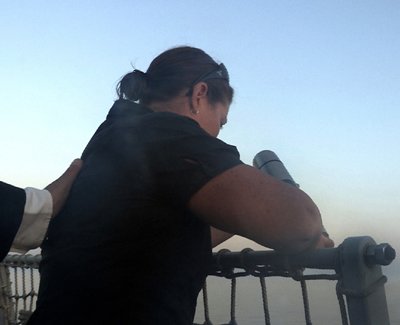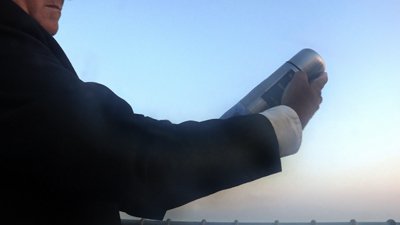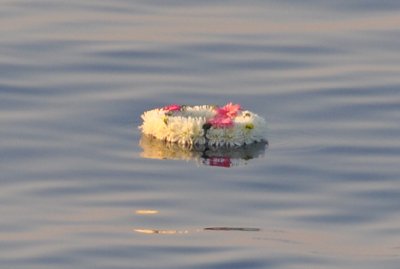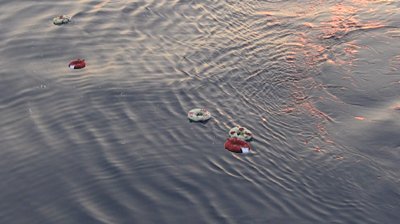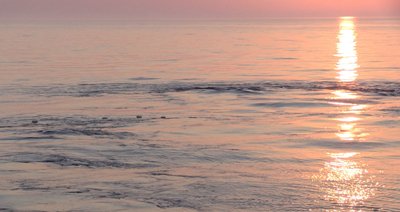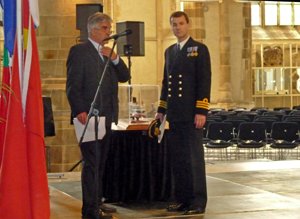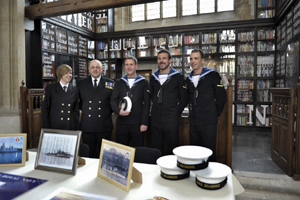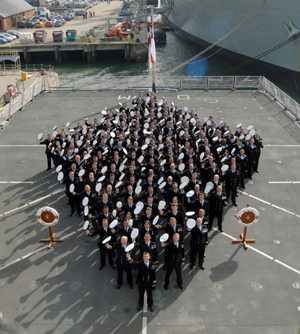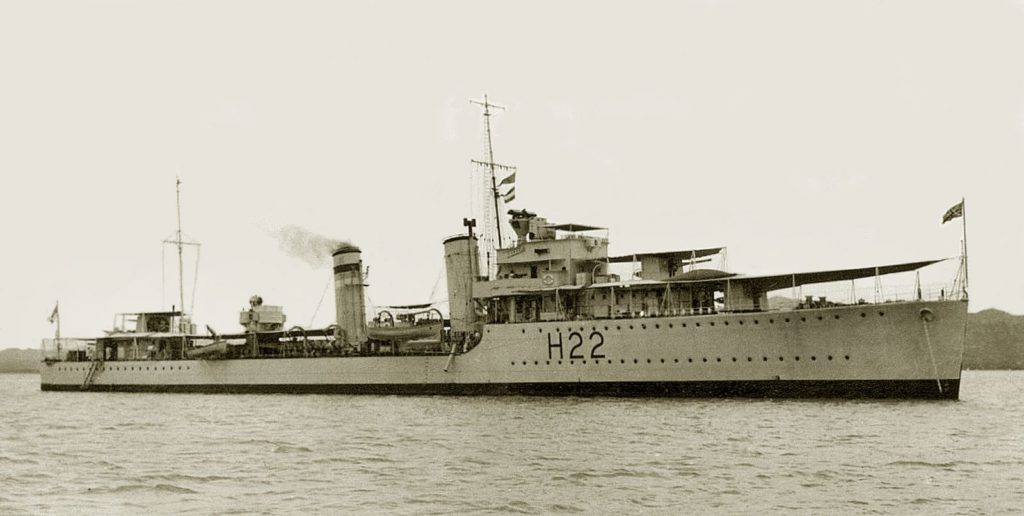
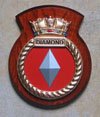 The old HMS DIAMOND – H22 D-class destroyer
The old HMS DIAMOND – H22 D-class destroyer 
The ship mounted four 45-calibre 4.7-inch Mark IX guns in single mounts. For anti-aircraft (AA) defence, Diamond had a single 12-pounder (3-inch (76.2 mm)) gun between her funnels and two 40-millimetre (1.6 in) QF 2-pounder Mark II guns mounted on the side of her bridge. She was fitted with two above-water quadruple torpedo tube mounts for 21-inch torpedoes. One depth charge rail and two throwers were fitted; 20 depth charges were originally carried, but this increased to 35 shortly after the war began.
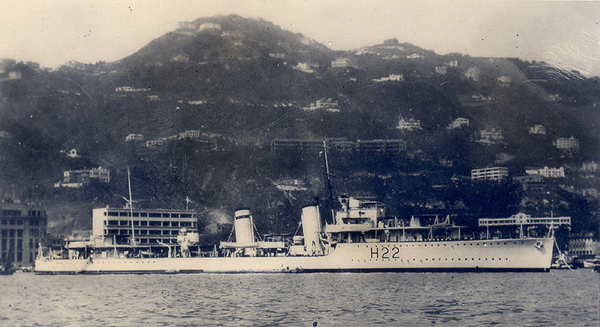
HMS Diamond was ordered on 2 February 1931 under the 1930 Naval Estimates, and was laid down at Vickers-Armstrong’s yard at Barrow-in-Furness on 29 September 1931. She was launched on 8 April 1932 and completed on 3 November 1933, at a total cost of £223,509, excluding equipment supplied by the Admiralty, such as weapons, ammunition and wireless equipment. The ship was initially assigned to the 1st Destroyer Flotilla in the Mediterranean and made a brief deployment to the Persian Gulf and Red Sea in September–November 1933. Diamond was refitted at Devonport Dockyard between 3 September and 27 October 1934 for service on the China Station with the 8th (later the 21st) Destroyer Flotilla and arrived there in January 1935, where she remained for the next four years.
The ship began a refit at Singapore on 7 August 1939 and she was transferred to the Mediterranean Fleet after it was completed in November. Diamond arrived at Malta on 19 December, but she was transferred to the South Atlantic Station the following month. She departed Malta on 8 January 1940, bound for Freetown where she joined the 20th Destroyer Division for escort duties. In April the ship returned to the Mediterranean where Diamond was assigned to the newly formed 10th Destroyer Flotilla after a short refit at Malta.
She was slightly damaged by air attacks on 11 and 17 June near Malta after the Italians declared war on the Allies on 10 June. Together with her sisters Dainty, Defender, the Australian destroyer Stuart, and the light cruisers Capetown and Liverpool, she escorted Convoy AN.2 from Egypt to various ports in the Aegean Sea in late July. Diamond bombarded the Italian seaplane base at Bomba, Libya on 23 August. A week later she escorted four transports to Malta with Dainty and the destroyers Jervis and Juno as part of Operation Hats. The ship escorted Convoy MB.8 during Operation Collar. After reaching Malta on 26 November, Diamond joined Force D and sailed to rendezvous with Force H, coming from Gibraltar. The next day, after the British forces had combined, they were spotted by the Italians and the inconclusive Battle of Cape Spartivento was fought.
During Operation Excess, Diamond and Defender escorted Convoy MW.5 to Malta in January 1941. The ship escorted a convoy of four freighters from Malta to Alexandria in mid-April. Shortly afterwards, she began evacuating Allied troops from Greece. On 27 April 1941, Diamond and another destroyer, Wryneck, rescued over 500 troops from the sinking Dutch troopship, Slamat, and set out for Crete. However, both ships were attacked and sunk about four hours later by German Messerschmitt Bf 109 fighters and Junkers Ju 88 bombers. Only one officer, 41 enlisted men and eight soldiers from all three ships were rescued.
COMMANDER, CAPTAIN IAN CLARKE OF THE BRITISH ROYAL NAVY COMMEMORATES THE 1941 DISASTER WITH HMS DIAMOND, HMS WRYNECK AND ss SLAMAT.
MEDITERRANEAN: NORTH OF CRETE – GREECE
26 Juni 26th 2012, 06.00 AM


Panorama picture- Arend Schmale

WHERE IT HAPPENED ON APRIL 27th 1941…..
In yellow the Commemoration route of HMS Diamond to the graves of HMS Diamond and HMS Wryneck victims.
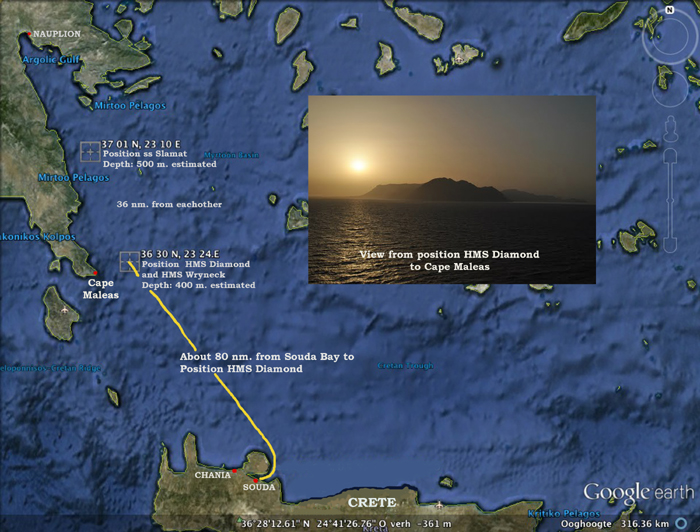
CAPTAINS’ COMMEMORATION DINNER ON THE EVE OF THE CEREMONY
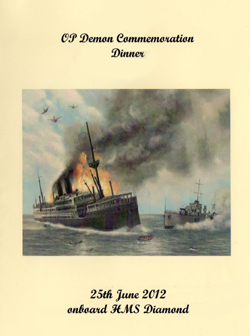


Captains’ Commemoration dinner with (from left-clockwise-to the right): Lieutenant Allen (HMS Diamond), Arend Schmale (Royal Rotterdam Lloyd Museum), Petty Officer Berry (HMS Diamond), Kate Saxton (Granddaughter of the Slamat surgeon), Sailor Barnes (HMS Diamond), Ed van Lierde (Royal Rotterdam Lloyd Museum), HMS Diamond Commander Ian Clarke and Frans Luidinga (Son of the Slamat Captain).
A VERY EMOTIONAL MEMORAL SERVICE BY
HMS Diamond Chaplain, Reverend Andrew Corness
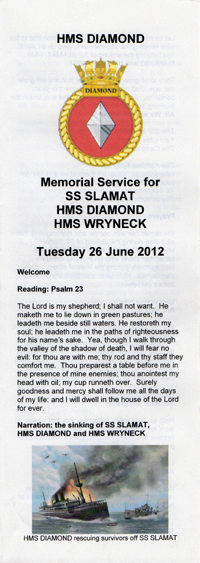 |
 |
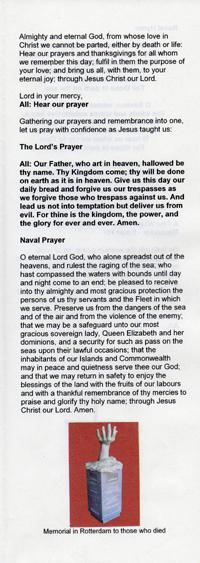 |
 |
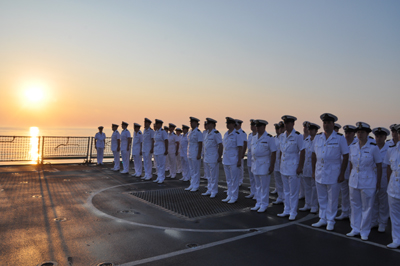
HMS Diamond officer aligned at sunrise, 6 AM …
Picture-Kate Saxton
|
…… as well as the petty officers and sailors
Picure-Kate Saxton
|
|
The crew members who were part of the ceremony at the ‘Great Slamat/Diamond/Wryneck Commemoration’ in The Netherlands (April, 2011), standing on a place of honour.
Picture-Kate Saxton
|
HMS Diamond Chaplain, Reverend Andrew Corness takes the ceremony by with a petty officer.
Picture-Kate Saxton
|
|
The Memorail service pamflet in the hands of a sailor ….
Picture-Matthew Jackson (MOD media)
|
A ‘touched’ sailor watching the course of the ceremony …..
Picture-Matthew Jackson (MOD media)
|
|
|
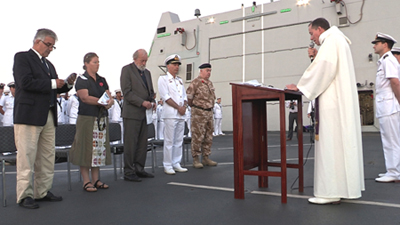 |
|
From left to right: Ed van Lierde (Chairman Royal Rotterdam Lloyd Museum), Kate Saxton (Granddaughter of the Slamat Surgeon), Frans Luidinga (Son of the Slamat Captain), Vice-Admiral Konstatinos Mazarakis-Enian (Vice-Admiral and Commander-in-Chief of the Greek Navy), Colonel Paul Morphet (British Defence Attache to Greece), Chaplain Andrew Corness (HMS Diamond Chaplain) and Captain Ian Clarke (Commander HMS Diamond).
Picture-Arend Schmale
|
|
|
Petty officer, Berry reads her part of the disaster story ……
Picture-Arend Schmale
|
Petty officer, Morris reads his part of the sad story. Left of him Captain Ian Clarke (Commander HMS Diamond), the Deputy Commander and a Sailor
Picture-Kate Saxton
|
|
Sailor Barnes continues the order of events …..
Picture-Arend Schmale
|
The end of the tragic story expressed by Lieutenant Allen.
Picture-Arend Schmale
|
|
Vice-Admiral Marazakis-Ainian giving his address. To his right: Lieutenant-Commander, Konstantinos Bakas (Greek Navy)
Picture-Kate Saxton
|
HMS Diamond Commander, Captain Ian Clarke with the last speech after which he opens the ceremonial part……….
Picture-Arend Schmale
|
|
De mannelijke bemanningsleden zetten hun uniformpet af ……
Picture-Arend Schmale
|
Vice-Admiral Konstatinos Mazarakis-Enian laying a poppy wreath at the site on behalf of the Greek Navy…..
Picture-Arend Schmale
|
|
Commander, Captain Ian Clarke laying the second poppy wreath on behalf of the British Royal Navy…..
Picture-Arend Schmale
|
Kate Saxton watching the impressive ceremony with withheld emotions ……
Picture-Arend Schmale
|
|
Frans Luidinga ready to lay his flower wreath on the waveless Mediterranean ……
Picture-Arend Schmale
|
When Frans is laying the flower wreath for his father, emotions on his face are visible.
Picture-Arend Schmale
|
|
Kate Saxton laying her wreath for her grandfather …… from HMS Diamond tot the 1941-HMS Diamond
Picture-Arend Schmale
|
Tears of emotion when Kate is standing at the grave of her grandfather …. she is the first member of her family who, after 71 long years, is getting this great privilage.
Picture-Arend Schmale
|
|
Last in a row of five, Ed van Lierde is laying the Royal Rotterdam Lloyd Museum flower wreath as close as possible to the other four.
Picture-Arend Schmale
|
Kate throws the capsule overboard with her letter and those from her New Zealand family members …..
Pictures-Arend Schmale
|
|
Ed van Lierde is sending a message to HMS Diamond grave in which the names of all 983 victims are mentioned …..
Picture-Arend Schmale
|
The flower wreath of Kate ……
Picture-Kate Saxton
|
|
‘The five’ trying to get each other’s company …
Picture-Arend Schmale
|
HMS Diamond is sailing dead-slow-ahead …. the wreaths are disappearing in the distance ……
Picture-Kate Saxton
|
Important footage for the Slamat documentary


In a letter to her family granddaughter Kate Saxton tells her story ……


So where to start ? – maybe why I got to be part of this experience.
I finished my work in PNG in December ‘11 after 4 years as a contractor to a Law and Justice Program on an island called Bougainville and decided that I wouldn’t renew my contract and secondly that I would take a year of travel round a few Countries. So far, starting in January, I have been in Germany, France, Switzerland, England, Scotland, Lebanon, Greece, Turkey, Jordan, Cyprus, UAE, Egypt, Israel and back to Crete in Greece for this ceremony. I am now in Macedonia having flown to Albania for a look around there and next I think will be Bulgaria and up through the Balkan States and Eastern and Central Europe hopefully ending up in Estonia in a few months time.
A few months ago my mother, Mary mentioned the possibility of Ed van Lierde (Royal Rotterdam Lloyd Museum) being invited onto the HMS Diamond as it passed through Greece on its way to deployment in the Gulf. If you look at the website of the Royal Rotterdam Lloyd Museum it goes into detail about the 70th anniversary commemoration of the sinking of the Slamat, Diamond and Wryneck held in Rotterdam last year. Invited to that commemoration last year were Ian Clarke, who was and is the Commanding Officer (Captain) of the HMS Diamond, and 7 of his crew (all were present on the ship during the ceremony).

Like Ed and Frans Luidinga (son of the ss Slamat Captain also killed along with Len and 981 others) and Mary and you all and many other people, Ian was very passionate about this sinking of his ship’s namesake and so in contact with Ed it was arranged to hold a memorial service over the given coordinates of the Diamond’s sinking/resting place. The Wryneck is believed to be relatively close by and the Slamat some kilometres away.
So it came to be that I was nearby in the Middle East and that coincided with this ceremony (a date could never be set in concrete due to ships trials etc but it was a punt Ed and Frans and I took in booking tickets to Crete at that time hoping it would pay off). Ed managed to get an invitation for Frans Luidinga and me and he took a two man film crew to record the event. Ed and the film crew are putting a documentary together on ‘Operation Demon’ and this commemoration. The Film crew are Arend Schmale and Ton Kellner both from Holland. They gave of their time completely for free to do this and spent 7 days in Crete with us.






We also had three fresh flower wreaths locally made for the ceremony; one for Len and I took the liberty of making it from all of his family. On the wreath I attached two quotes. One was an extract I took from a letter Ga had written to Len, believing him to still be alive :”…your love helps me always. I love you with everything in me. Kisses from the wee girls and all my love my own dearest for always and always. You are never out of my heart and thoughts, your own Joanie”. And also I attached a quote from Len in a letter he had written to Ga (from the poem that is featured in ‘posted love’)… “I am fighting for my King because the old traditions rouse me. I am fighting for my Country because my Country’s cause is still the best cause in the world: and I am fighting for you and our children because you are my life”.
The other two wreaths were for Frans’ father from Frans and family and one wreath was from the Royal Rotterdam Lloyd Museum from Ed for all killed at this time.
So all five of us were picked up by a couple of the HMS Diamond crew on the afternoon of the 25th. The HMS Diamond was in port, not at Souda as we thought but at a smaller Greek Naval base about 20 minutes from Chania (If you are wondering when you get to see all the photos why there are no photos from us of the ship from port it is because filming in and around the base was prohibited). We boarded the ship and were greeted by Logistics Officer Lieutenant Commander Simon Boon and 10 minutes later by HMS Diamond Commander Captain Ian Clarke.


The ship left port and travelled only a short distance before dropping anchor for a few hours. While we were there, there was a short visit from the Rear Admiral of the Greek Navy – Rear Admiral Konstantinos Mazarakis-Enian and the reason for dropping anchor just out of port was to wait there until the Rear Admiral returned late that evening so he could sleep on the ship and join us for the ceremony the following morning.
After dropping anchor we all joined Ian Clarke and three of his crew members (an officer, a Petty officer and a sailor) for dinner in his cabin. Dinner was only moderately formal (thank goodness) and Ed and Frans and I all got a chance to give speeches of thanks. The other three crew members present at the dinner had all attended the ceremony in Rotterdam last year with Ian Clarke and so they knew Ed and Frans and certainly had an interest in the ceremony which made it even more special to meet them.

Dinner over and we all retired to the Officers Ward and then bed about midnight. During the night the ship sailed to the site of the Diamond’s and Wryneck’s sinking and when we woke early in the morning we were already over the site.
The ceremony was set to start at 06.00 and prior to it commencing we all went up to the bridge and took some time to reflect. The morning was so very still and the sea was as calm as it could be. We were up before sunrise so it was quite dark and eerie, almost misty – perfect really for the sombreness of the ceremony about to unfold.
I am told it doesn’t always happen but for this ceremony the whole of the crew (bar those needed to keep the ship going) were present – some 200 crew all immaculately turned out. You can probably see from the photos that the ceremony took place on the rear deck of the ship (usually where the choppers land etc so plenty of room) and the crew were all lined up in formation facing to where our seating was and we were facing the Chaplain and the Commander and some of his Officers.
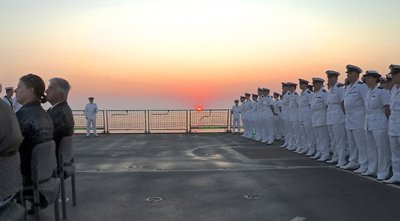
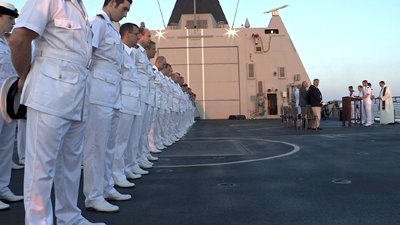
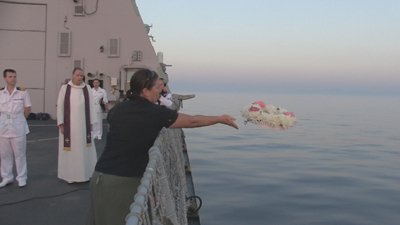
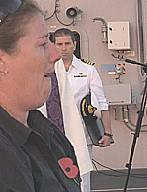
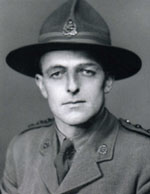
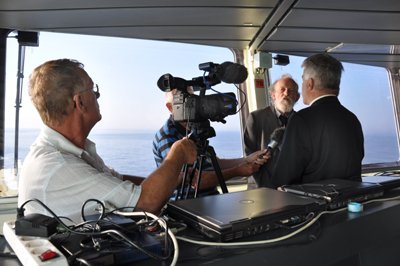
After the ceremony we had breakfast together and then we were treated to the most amazing and complete tour of the ship. This was great for the film crew and their footage but special for Frans who had never been on a warship and I was fascinated by the whole workings so I stuck with the film crew the whole day, including putting on overalls and going through the whole engine room etc.
I have to say I was so impressed by the hospitality and professionalism we were shown by every member of the crew we came in contact with. Every department (Engineers, Kitchen, Laundry, Officers, etc) dropped whatever they were doing to show us around their part of the ship and to explain their specific roles etc and did so with such amazing enthusiasm. Commander Clarke should certainly be very proud of all his crew and how they operated.

The great thing for me was that for the three days Frans and Ed and I had in Crete after this ceremony and even after they had left we kept seeing crew members who were lucky enough to be granted shore time and again all were fantastic then too and a few beers and coffees were had with some crew even ashore. I think as one group I caught up with said, when it comes to lives lost at sea fighting in a war they have a special respect and it means more to them than other ceremonies, and it hits home it could be them, so I think for some this ceremony was special to them too and one that will be remembered.
Once ashore Ed did not stop his tireless work for remembering the lives lost and so he spoke with a reporter from the local paper and as a result a full colour page article was written on the ceremony. He also was interviewed by the television news team. Ed and Frans also visited the local maritime museum and as a result Ed and the director of that museum will cooperate in future. He also hopes to hear from the Rear Admiral of the Greek Navy and maybe more information (footage for the Slamat/Diamond/Wryneck documentary) will come through those channels.
For me it is difficult to describe the whole week in Crete. I think the ceremony was done very professionally and with the respect and care you all would have wanted. I feel so lucky that I was in a position to attend but I feel sorry that many of you who really should have had this opportunity weren’t there and above anyone I speak of Cass, Annie and Mary. I am so very proud that as a family you all expressed your thoughts and words to Len and I hope in some way that Frans’ and Ed’s and my being there and the laying of the wreaths and the delivering of your words goes in some way to your paying your respects to so close where it is believed Len died.
It was so very kind, and that is an understatement, of Commanding Officer Ian Clarke and his crew to facilitate this ceremony and without his and Ed’s dedication to this ceremony it would surely never have happened.
I hope that you will soon have access to all the photos and documents of this time and the next thing will be a special DVD (within 2 to 3 month) with footage of this impressive commemoration, this footage will be part of the documentary but that is at least one to two years away and I understand the Royal Rotterdam Lloyd Museum hopes to release it whichever year it is completed on the 27th of April.
Lots of love to you all ………………… Kate xox
What the Media wrote about it ……
British Royal Navy – Matthew Jackson (MOD media)
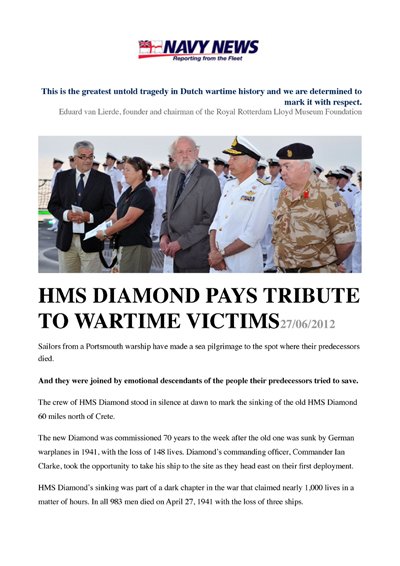
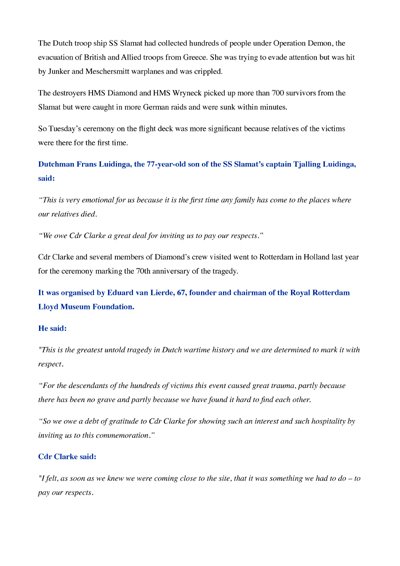
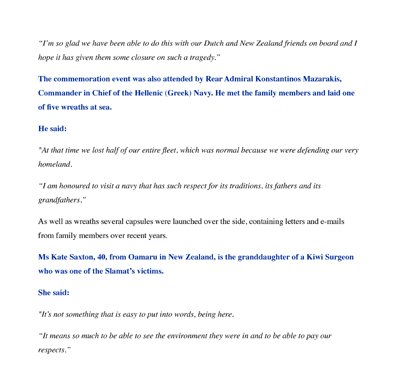
CHANIA’-CRETE NEWSPAPER: ‘HANIOTIKA NEA’ – June 29th 2012
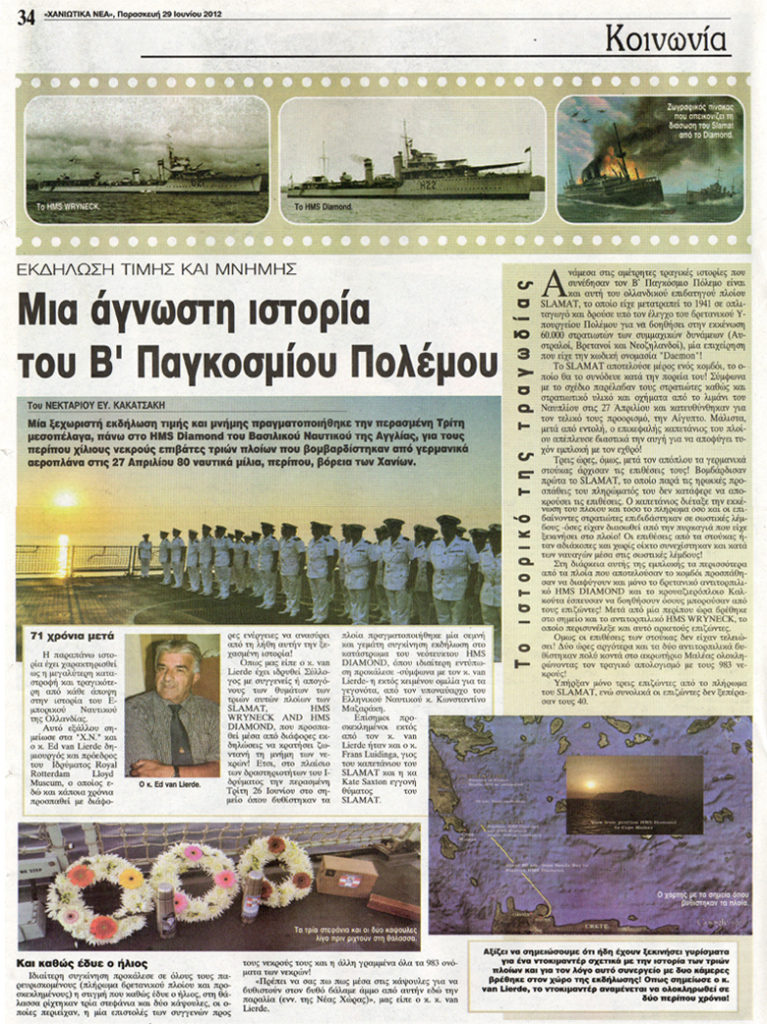
This translation is a gift by the management of the Danaos Hotel at Chania -Greece
Last Tuesday a special honor and memory event took place on board of the British Royal Navy destroyer, HMS Diamond for about a thousand victims of three ships that were bombed by German planes on April 27, 1941 some 80 nautical miles, roughly, North of Crete.
The history of this tragedy
Among the countless tragic stories that happened in World War II is that of the Dutch passenger ship SLAMAT, which was transformed in 1941 into trooptransporter and operated under the control of the British War Department to assist in the evacuation of 60,000 soldiers of the allied forces (Australian , British and New Zealand), an operation with the the code name “Demon”!
During this engagement most of the ships in convoy tried to escape and the British destroyers HMS DIAMOND rushed to help the survivors! After an hour the British destroyer HMS WRYNECK, collected a many survivors. But the attacks of the Stukas were not finished! Two hours later the two destroyers were sunk near Cape Maleas completing the tragic with 983 dead! There were only three survivors from the crew of SLAMAT, while overall the survivors have not exceeded 40.
71 years after
The above story is described as the greatest and most tragic disaster in every respect in the history of the Merchant Navy of the Netherlands. It is also noted that Mr. Ed van Lierde, founder and president of the Royal Rotterdam Lloyd Museum Foundation, is already for some years trying to avoid that this forgotten disaster will sink into oblivion! As we said van Lierde established association with relatives and descendants of victims of these three ships SLAMAT, HMS WRYNECK AND HMS DIAMOND, trying to keep the memory alive of the dead by organising various events! Thus, last Tuesday, June 26 on the exact spot where the ships sank a modest and ‘full of emotion’ ceremony was held on the large deck of the newly HMS DIAMOND which, according to Mr. van Lierde, caused a deep emotional impression. The Greek Navy Rear Admiral Konstantinos Mazarakis Ainian did his speech by heart.
Besides Mr. van Lierde, also Mr. Frans Luidinga, son of the SLAMAT Captain and Ms. Kate Saxton granddaughter of the SLAMAT surgeon, were invited by the Commander of HMS Diamond.
And the sun was rising.
‘SLAMAT’HERDENKING – 2007
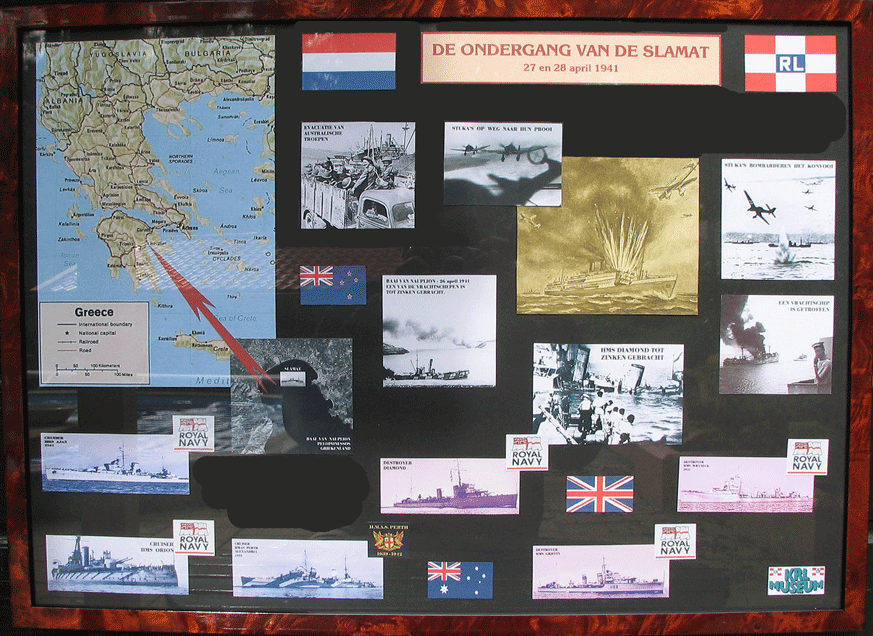


‘GREAT SLAMAT/DIAMOND/WRYNECK’ COMMEMORATION – 2011

CONTRIBUTION OF THE BRITISH ROYAL NAVY TO OUR SLAMAT/DIAMOND/WRYNECK – COMMEMORATION
The Dutch never returned thanks to the British for the rescue attempts of the Slamat crew and allied troops on board the Slamat by the HMS Diamond and HMS Wryneck crew members. On April 27, 2011 we made an end to this negligense and invited Commander Ian Clarke and seven crew members of the modern HMS Diamond to be part of the official ceremony.
|
Ed van Lierde and Commander Ian Clarke in a preparatory conversation during the ‘Great Slamat/Diamond/Wryneck’ Commemoration
|
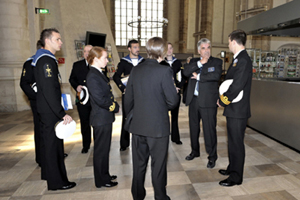 A short explanation was for the Diamond crew sufficient enough to performe fantasticly.
|
|
The Diamond crew organised their own exposition in the Laurenschurch.
………………………………………………………………………………………
|
 During the unveiling of the monument they formed a beautiful and impressing guard.
……………………………………………………………………………………….
|
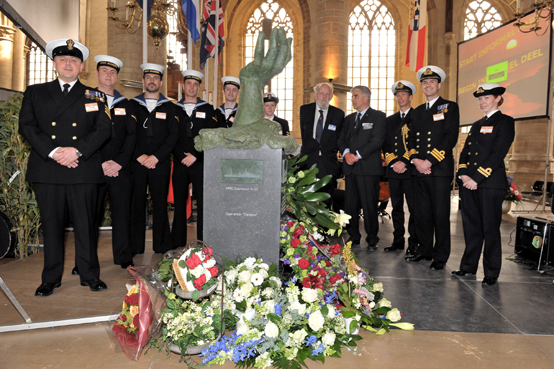
The representatives of the Royal British Navy with Frans Luidinga (Son of the Slamat Captain, Tjalling Luidinga – 5th from right) and Ed van Lierde (Founder and Chairman of the Royal Rotterdam Lloyd Museum – 4th from right).
Captain Lambourn, British Defence Attaché to The Benelux (3rd from right)
Commander Ian Clarke Commanding Officer HMS Diamond (2nd from right)
Lt. Commander Allen (1st from right)
PO Morris, PO Berry, LS James, LET Barnes, LET Chadwick, LSC Meggeson.
During the Commemoration the ‘Coat of Arms’ of HMS Diamond (shown down below) was presented by PO Tanja Berry to the Royal Rotterdam Lloyd Museum. A great reason and a good moment to present the Slamat model (scale: 1 – 1250) which will sail from now on with the modern HMS Diamond.

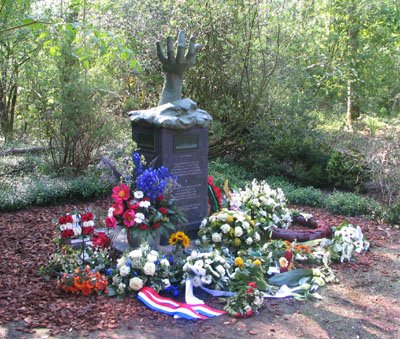
The Slamat monument in the garden of the Royal Rotterdam Lloyd Museum at Oudehorne
DE NEW HMS DIAMOND – 2010
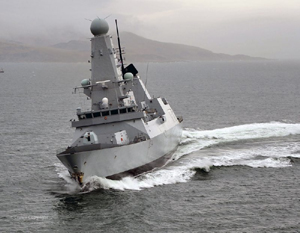
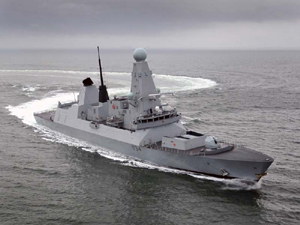
HMS Diamond is part of a class of 6 new Type 45 ‘Daring class’ Destroyers, the ship’s primary business is defending task groups, including NATO and multi-national groups, from attacking aircraft. She is equipped with the powerful British-built SAMPSON radar as well as a long-range radar and combat system that is powerful enough to identify and classify aircraft contacts from Frankfurt to Edinburgh whilst the ship is alongside in Wilhelmshaven. To give some idea of the scale of the Type 45, her onboard power plant is rated at 62,000 horsepower and can produce sufficient electricity to light a small-sized city with a population of 80,000. The ship’s fuel storage tanks have a volume equivalent to approximately half the volume of an Olympic swimming pool. When fully laden she will displace in excess of 8000 tonnes of sea water which is equivalent to more than the weight of 1000 un-laden London buses and more than the weight of the Eiffel tower.
DE FIRST COMMANDER OF HMS DIAMOND D-34
COMMANDER IAN B. CLARKE
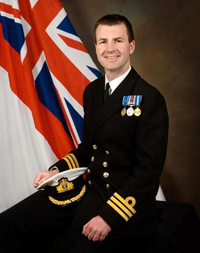

Commander Ian Clarke, born in 1972, grew up in Elms Vale (Dover). The dad to two daughters (2011) with beautiful blue eyes passed out of the Britannia Royal Naval College, Dartmouth, as a Warfare Officer in 1992. He was part of the mission aboard destroyer HMS Newcastle which helped Montserrat during volcanic activity. In 2003 he joined the destroyer HMS Manchester which helped to disrupt trans-Caribbean drug shipments. In 2005 he graduated from from Kingston University, attaining an Master-Science in Technology (Maritime Operations). Commander Clarke took in the period 2007 – 2009 charge of the Offshore Patrol Vessel HMS Tyne, often carrying out Fishery Protection duties in the Dover Straits. In June 2010 he assumed command of HMS Diamond.
Ian B. Clarke is a keen sailor and also enjoys skiing and scuba diving.
HET FIRST FOREIGN VISIT OF HMS DIAMOND WILELMSHAVEN-GERMANY 21 juli 2011
The British Royal Navy warship, HMS DIAMOND, visited Wilhelmshaven – Germany in the period: 21-24 July. The Royal Navy’s newest warship, is usually based in Portsmouth on the South coast of England. Actually it was the intention to call the Dutch Naval Base at Den Helder but a because of a shortage of quay space HMS Diamond had to change her course to Germany. So she marked her acceptance into full Royal Navy service with her first overseas visit as guests at the Naval Base in Wilhelmshaven. Commanding Officer of the ship’s 190-strong crew, Commander Ian Clarke, said, ‘It is always a great pleasure to visit Germany and the German Navy, with whom we have such close professional and operational links.’ He added, ‘My team have been working exceptionally hard since Air Defence destroyer HMS DIAMOND left the shipyard last September and this visit will be a great way of marking our arrival into service’.
PICTURES ARRIVAL
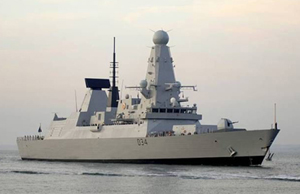
HMS Diamond approaching quietly
|
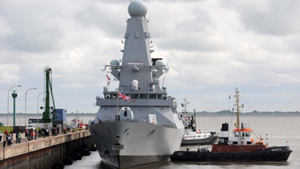 HMS Diamond mooring at Wilhelmshaven
|
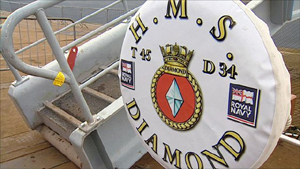
The gangway
|
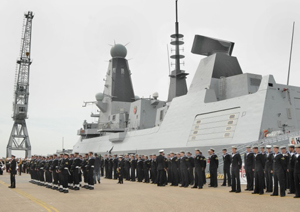 Calling the roll ashore
|
|
HMS Diamond crew in Diamond shape at the poop
|
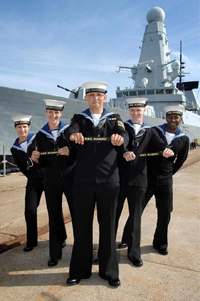 Five crewmembers showing with their cap name with pride
|
RECEPTION HMS DIAMOND AT WILHELMSHAVEN – July 21 2011
Whilst not open to the public during her short stay, there was a press conference on board and Commander Clarke and his crew welcomed persons from the German Navy and the diplomatic community to brief them on the capabilities that this new class of ship could offer any multinational military operation. Commander Ian Clarke welcomed as special guests Mr. Ed van Lierde, Founder and Chairman of the Royal Rotterdam Lloyd Museum Foundation and his spouse Mrs. Josje van Lierde-Olivier.
PICTURES BY HMS DIAMOND CREW MEMBER

HMS Diamond Commander Ian Clarke en Ed van Lierde posing in front of the permanent mini-exposition of the Slamat Commemoration

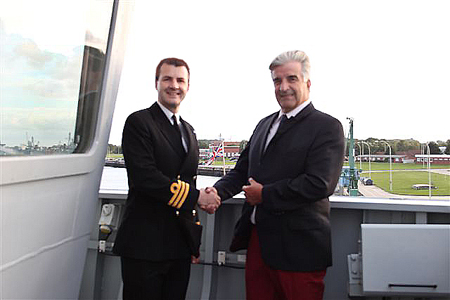
Left: At the navigation bridge with Josje van Lierde-Olivier in the Commander seat. Right: HMS Diamond starboard Bridge
wing – Ian Clarke and Ed shaking hands on future cooperation!


